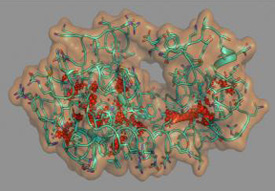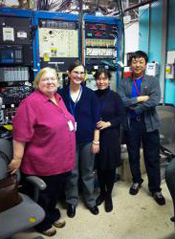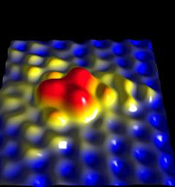__________________________________________________________________________
SSRL Headlines Vol. 12, No. 3 - September 2011
__________________________________________________________________________
Contents of this Issue:
__________________________________________________________________________
1.
From the Director of SSRL: 2011 Users' Meeting - A Chance to Provide Strategic Input
Thanks to the efforts of the SSRL staff and the input of many users, the new SSRL strategic plan is moving forward swiftly. I encourage all our users to attend the SSRL/LCLS Users' Meeting, October 22-26, to learn more about our plans and to share your feedback. In my talk, scheduled for 10:10 a.m. on Monday, October 24, I'll share an overview of the plan; Britt Hedman and Mike Toney's talks, scheduled for 10:30 and 11:00 a.m. on Wednesday, October 26, will offer more details on the scientific programs and beam line plans.
I also look forward to Pat Dehmer's keynote, Scientific User Facilities: Their Importance in the National Research Strategy, which she will give at 9:30 a.m. on Wednesday the 26th.
Looking forward to seeing you at the Users' Meeting!
—Chi-Chang Kao
2. Science Highlight —
X-ray Nanotomography Imaging for Circuit Integrity
(contact: Joy Andrews Hayter, jandrews@slac.stanford.edu)
|
 |
As cell phones, computers, and other electronic equipment have become part of our daily lives, so too have integrated circuits. Also known as microchips, these semiconductors patterned with trace elements serve as the brains of electronic devices, controlling processes, storing data, and converting information from digital to analog, to name only a few applications. With increasing prevalence, however,
the chips are becoming targets of malicious attacks. Integrated circuits are susceptible to "hardware Trojans" that can be inserted during production, testing, or distribution to cause failure or compromise the circuit. Because hardware Trojans vary considerably and are always changing, thorough and non-destructive methods of scanning integrated circuit chips for unwanted modifications are needed.
Recently, a team of researchers from the University of Southern California Information Sciences Institute and Xradia Inc. used the transmission x-ray microscope at Stanford Synchrotron Radiation Lightsource Beam Line 6-2 to develop a new method of obtaining nondestructive, high-resolution images of integrated circuits. Like a dot-matrix printer, the method raster-scans an integrated circuit chip with the x-ray beam, and then strings together hundreds of small images to create a full 2D image of the chip. Advanced algorithms then compile many such 2D images, each taken from a different angle, to create a full 3D image of the chip.
Such novel imaging methods enable the timely screening of integrated circuit chips and could be used to inspect chips for changes to the original design, be they malicious or accidental. This could be especially useful in critical applications including defense, medical and financial records, and aeronautics.
These imaging results were published in the Proceedings of the 36th GOMACTech Conference.
To learn more about this research see the
full scientific highlight.
3.
Science Feature: Proteins Better Analyzed at Room Temperature, Report Finds
(SLAC News Center article by Glennda Chui)
|
 |
Proteins are jittery things that continually conform. But the practice of freezing protein crystals for analysis—a mainstay of biology for 40 years—erases most of the information about these motions, leading scientists to miss vital clues about how these molecules operate, according to a report by researchers at SLAC, Lawrence Berkeley National Laboratory, UC-Berkeley, and UC-San Francisco in the September 13 early edition of the
Proceedings of the National Academy of Sciences.
The best way to catch a protein in all its many positions, they assert, is to analyze it at room temperature—an approach made easier by technological advances over the past decade at facilities including the Stanford Synchrotron Radiation Lightsource and Advanced Light Source, where these studies took place.
Read more in the
SLAC News Center.
4.
Science Feature: SSRL Invention Measures Stroke Damage in the Brain
(SLAC News Center article by Glennda Chui)
|
 |
A technique scientists invented for scanning ancient manuscripts at the Stanford Synchrotron Radiation Lightsource is now being used to probe the human brain, in research that could lead to new medical imaging methods and better treatments for stroke and other brain conditions. The studies, undertaken at SSRL, are led by cell biologist Helen Nichol, of the University of Saskatchewan, with $2.5 million in funding from the Canadian government and the Heart and Stroke Foundation of Canada.
Nichol's team, which includes a Stanford neurosurgeon and stem cell expert, other medical doctors, and experts in stroke research and medical imaging, reflects the broad ambitions of this research: to give doctors a better understanding of what they’re seeing in MRI scans of stroke patients; to improve diagnosis and guide treatments; and maybe even to develop new ways to peer inside the living brain.
Read more in the
SLAC News Center.
5.
Science Feature: Scientists Get First Detailed Look at Nitrogen Doping in Single-layer Graphene
(SLAC News Center article by Glennda Chui)
|
 |
The strength, flexibility, transparency, and high electrical conductivity of single-layer graphene make it a potentially unique and valuable material for the next generation of electronic devices. Made of carbon atoms arranged in a honeycomb pattern—think of a chicken-wire fence—it is 97 percent transparent and 1,000 times stronger than steel.
Researchers are working on ways to tune the properties of graphene for specific electronic applications. One way to do that is by doping—introducing small amounts of other elements, such as nitrogen or phosphorus, that either add or subtract electrons from the system. Widely used in silicon technology, doping has been carried out experimentally in single-layer graphene sheets; but until now, the details of how the dopant atoms fit into the sheet and bond with their carbon neighbors remained elusive.
In a study reported August 9 in Science, researchers from Columbia University, Sejong University in Korea, and SLAC and Brookhaven national laboratories used a combination of four techniques to make the first detailed images of nitrogen-doped graphene film.
Read more in the
SLAC News Center.
6. Science Feature: Faster Organic Semiconductors for Flexible Displays
(SLAC News Center and Stanford News Service article)
Organic semiconductors hold immense promise for use in thin film and flexible displays—picture an iPad you can roll up—but they haven’t yet reached the speeds needed to drive high definition displays. Inorganic materials such as silicon are fast and durable, but don’t bend, so the search for a fast, durable organic semiconductor continues.
Now a team led by researchers at Stanford and Harvard universities has developed a new organic semiconductor material that is among the speediest yet. The scientists also accelerated the development process by using a predictive approach that lopped many months—and could lop years—off the typical timeline.
Read more in the
SLAC News Center.
7.
Dr. Hirotsugu Tsuruta, SSRL Senior Scientist and Biophysicist, Passes Away
(contact: Britt Hedman, hedman@slac.stanford.edu)
Dr. Hirotsugu (Hiro) Tsuruta, a senior scientist and biophysicist, passed away on August 25, in Japan. Hiro worked for more than 20 years in the Structural Molecular Biology Program, providing leadership for the build-up of the SSRL biological small-angle x-ray scattering research program and the Beam Line 4-2 facility that today serves a large user community. His contributions were numerous and he leaves an international legacy in this growing area of science, for which he pursued new developments until the end. He explicitly wanted bioSAXS at SSRL to continue to thrive, and SSRL is committed to ensure that this is the case. What he created will enable a new science to emerge far into the future. SSRL will organize an event to honor his contributions in early 2012, and information will follow when plans become available.
8.
Announcements:
Users' Conference; UEC Membership; APS Meeting at SLAC; Seismic Upgrades; Changes to Gate Hours
(contact: Cathy Knotts, knotts@slac.stanford.edu)
Annual Users' Conference, October 22-26. Plan to participate in the annual
SSRL/LCLS
Users' Meeting and Workshops, October 22-26, to learn about groundbreaking research results and new opportunities in energy and
materials, biology, chemistry, catalysis, and environmental science. The
event website includes information on
keynote and award talks,
workshops, the
poster session and lodging.
Early
registration ends October 10, so sign up today!
Vote for Users' Organization Executive Committee Membership.
Having a full and engaged Users' Organization committee is essential, particularly during times of growth and change. Please take a few minutes to cast your ballots between now and October 24 to fill open positions on the Stanford Synchrotron Radiation Lightsource and Linac Coherent Light Source Users' Organization Executive Committees. The results will be announced during the Users' Meeting.
VOTE for the SSRL UOEC
VOTE for the LCLS UOEC
SLAC to Host November American Physical Society Meeting.
The California-Nevada Section of the American Physical Society will hold its 2011 annual meeting
at SLAC on Friday and Saturday, November 11-12. Plenary talks include Joachim Stöhr (SLAC) on the fascinating scientific opportunities with the Linac Coherent Light Source and Alessandra Lanzara (UCB) on recent developments in the area of superconductors. In addition, Nobel Laureate Burton Richter (SLAC) will speak on "Energy Policy Today" after the conference dinner.
This meeting also provides an opportunity for undergraduates, graduate students, postdocs, and others to present their research. Learn more and register on the
conference website.
Seismic Upgrade Project Completed.
The final phase of SSRL's most recent seismic upgrade project, funded in part by the American Recovery and Reinvestment Act, concluded this week. This project retrofitted the "old Beam Line 3 and 4" alcove walls, incidentally creating a high bay for a future undulator, and replaced the original roof blocks with properly reinforced precast blocks. The securing of the final half of the booster roof blocks to the walls was also completed. With the completion of this project, the SPEAR3 ring is completely retrofitted from Beam Line 5, through the West Pit, and up to Beam Line 1. In prior years, Building 120 and 131 were retrofitted. The portions of the SPEAR3 ring shielding that require future seismic upgrades include the tunnel at Beam Line 1, from Beam Line 2 to the East Pit, and from Beam Line 12 to Beam Line 5. We anticipate completing a substantial part of these remaining retrofits as we add new beam lines to several previously unused ports of SPEAR3.
Changes to Gate Hours.
Due to construction on the SLAC site, Gate 17 will open at 6:00 am on Saturday, October 1st and will remain open 24/7 until further notice. Gate 30 will be closed during the weekend and have restricted single lane access in the coming weeks due to road closures and altered traffic patterns. For more information, see
the full
announcement.
9.
Seen at SSRL: Jianhua He of SSRF and Joe McBrearty of DOE
|
 |
Shanghai Synchrotron Radiation Facility Deputy Director Jianhua He. On September 28 and 29, SSRL hosted Shanghai Synchrotron Radiation Facility Deputy Director Jianhua He and three colleagues, Ying Fan of User
and Facility Operations, Zheng Jiang of XAFS Beam Lines, and Honghong Li of the User Office. Dr. He presented a seminar on the status of SSRF, a third-generation synchrotron radiation light source that began operation in 2009. Funded by the Chinese Academy of Sciences,
the Shanghai local government, and the central government of China, the 3.5 GeV machine currently feeds seven beamlines, with six more under construction.
|
 |
Department of Energy Office of Science Deputy Director for Field Operations Joe McBrearty.
On September 27, Department of Energy Office of Science Deputy Director for Field Operations Joe McBrearty visited SLAC to meet with laboratory leadership. His visit included a tour of the Stanford Synchrotron Radiation Lightsource and conversations with SSRL
Science Director Britt Hedman and SSRL Senior Scientist Mike Toney.
__________________________________________________________________________
SSRL Headlines is published electronically monthly to inform SSRL users,
sponsors and other interested people about happenings at SSRL. SSRL is a
national synchrotron user facility operated for the U.S.
Department of Energy Office of Basic Energy Sciences by Stanford
University. Additional support for
the structural biology program is provided by the DOE
Office of Biological and Environmental Research, the NIH
National Center for Research Resources and the NIH National Institute of General Medical
Sciences. Additional information about
SSRL and its operation and schedules is available from the SSRL website.
__________________________________________________________________________
Unsubscribe
To leave the SSRL-HEADLINES distribution, send email as shown
below:
To: LISTSERV@SSRL.SLAC.STANFORD.EDU
Subject: (blank, or anything you like). The message body should read
SIGNOFF SSRL-HEADLINES
That's all it takes. (If we have an old email address for you
that is forwarded to your current address, the system may not recognize who
should be unsubscribed. In that case please write to
ssrl-headlines-request@ssrl.slac.stanford.edu and we'll try to figure out who
you are so that you can be unsubscribed.)
Subscribe
If a colleague would like to subscribe to the list, he or she
should send To: LISTSERV@SSRL.SLAC.STANFORD.EDU and use the
message body SUBSCRIBE SSRL-HEADLINES
| Last Updated: |
30 SEPTEMBER 2011 |
| Headlines Editor: |
Kelen Tuttle |
|





![]()


